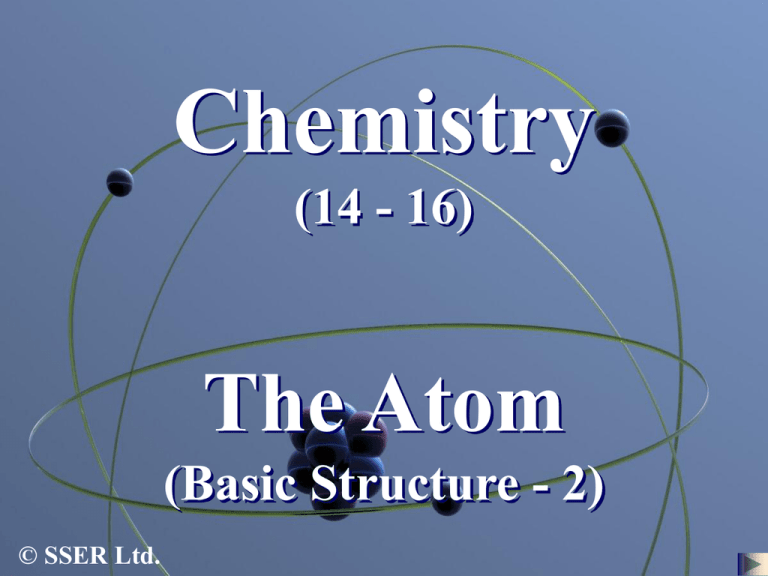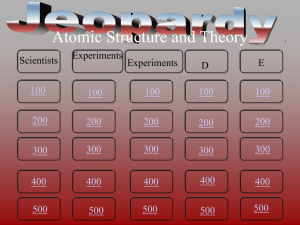
Chemistry
(14 - 16)
The Atom
(Basic Structure - 2)
© SSER Ltd.
Electronic Structure
The electron levels fill as we move
across and down the Periodic Table.
Group 1 - Electronic Structure
Li
3
Na
2,1
2,8,1
11
K
In Group 1 of the Periodic Table,
all of the elements have one
electron in their outer shell.
2,8,8,1
19
This similarity in electron
structure explains the fact that
the elements in Group 1 have
similar chemical properties.
Rb
2,8,18,8,1
Cs
2,8,18,18,8,1
37
55
Group 1 - Electronic Structure
Li
3
Na
11
K
19
Rb
2,1
In most of their chemical reactions,
the atoms release this electron and
become positively charged ions.
2,8,1
Group 1 elements all have similar
chemical properties, but the
presence of an increasing number of
2,8,8,1 complete electron shells inside the
outer level does affect the
properties.
2,8,18,8,1
37
Cs
55
2,8,18,18,8,1
Group 1 - Electronic Structure
Li
3
Na
2,1
2,8,1
11
K
2,8,8,1
19
As we descend the group,
the metals become more reactive.
Lithium reacts with cold water on
contact and slowly dissolves to
form a solution of lithium
hydroxide.
Caesium reacts explosively on
contact with cold water to form a
solution of caesium hydroxide.
Rb
2,8,18,8,1
Cs
2,8,18,18,8,1
37
55
Group 7 - Electronic Structure
9
F
2,7
Cl
2,8,7
Br
2,8,18,7
17
35
53
I
In Group 7 of the Periodic Table
(Halogens) all of the elements
have an incomplete outer shell one electron is needed to
complete it.
This similarity in electron
structure gives the elements in
Group 7 similar chemical
properties.
2,8,18,18,7
Group 7 - Electronic Structure
9
F
2,7
Cl
2,8,7
Br
2,8,18,7
Group 7 elements all form
diatomic molecules, e.g. F2, Cl2.
As the group is descended, the
elements become less reactive.
17
35
53
I
2,8,18,18,7
The elements in Group 7 all form diatomic molecules, e.g. F2, Cl2.
They are all colourful non-metals.
Group 0 - Electronic Structure
He
2
Ne
10
Ar
18
In Group 0 of the Periodic Table, all
of the elements have full outer
2
shells of electrons.
This similarity in electron structure
explains gives the elements
2,8
in Group 0 similar chemical
properties.
2,8,8 The elements are unreactive and
monatomic (single atoms).
36
Kr
2,8,18,8
Xe
2,8,18,18,8
54
Group 0 - Electronic Structure
He
2
Ne
10
Ar
18
In Group 0 the elements all have
similar chemical properties, but the
2
presence of an increasing number of
complete electron shells does affect
their properties.
2,8
As the group is descended, the gases
become heavier and ‘more’ reactive.
2,8,8 Helium and Xenon have no known
natural compounds.
36
Kr
2,8,18,8
Xe
2,8,18,18,8
54
A Space Filling Model of
Xenon Tetrafluoride
Although Xenon has no known natural compounds, it can be
induced to react with Fluorine under extreme conditions.
Electron Levels (Shells)
Drag the electronic configurations and names into the correct
places for the elements below…
Electron Levels (Shells)
Drag the electronic configurations and names into the correct
places for the elements below…
1st Short Period - Electronic Structure
If we examine the elements in the first short period of the
Periodic Table we can see a pattern in their atomic number...
Li
3
Be
4
B
5
C
6
N
7
O
8
9
F
Ne
10
Across the Periodic Table (left to right), the atomic number
increases by one each time.
As the atomic number is
also the same as the
number of electrons in an
atom – then the number of
electrons also increases
with the increase in atomic
number.
1st Short Period - Electronic Structure
The numbers below each atom are
the electron configurations of the
atoms, e.g. the electron configuration
of a carbon atom is 2,4.
This means that a carbon atom has
two electrons in the first level and
four electrons in the second level.
2nd Short Period - Electronic Structure
The electron configuration of a sulfur
atom is 2,8,6.
This means that a sulfur atom has:
...two electrons in the first level...
...eight electrons in the second level...
...six electrons in the third level.
Electronic Structure - Properties
The elements change gradually
in both physical and chemical
properties across the period
from left to right.
The elements on the left are metallic
elements, and the elements to the
right are non-metallic.
Electronic Structure - Properties
Sodium is a
reactive metal
Chlorine is a
reactive gas
Argon is an
unreactive gas
Electronic Structure and Chemical Properties
The electronic structures dictate that
elements with only a few electrons in
their outer levels (e.g. Na, Mg, Al)
can most easily lose electrons,
gaining an inert gas configuration
and thus form positive ions.
Electronic Structure and Chemical Properties
Elements with nearly complete
outer shells (e.g. Cl) can most easily
gain electrons, gaining an inert gas
configuration and thus form
negative ions.
The inert gases (e.g. Ar) have a
complete outer electron shell and so
are unreactive.
What Determines The Element?
Elements differ from one another in that their atoms contain
different numbers of the sub-atomic particles. The number of
protons (or the atomic number) of an atom, is the factor which
decides the identity (element) of an atom.
All Lithium atoms have 3 protons.
All Carbon atoms have 6 protons.
All Uranium atoms have 92 protons.
Calculate the Particles in an Atom
For each element in turn, calculate the missing entries...
Atom
1
1
Helium
H
He
Protons
1
2
4
2
2
2
Carbon
C
6
12
6
6
6
Chlorine
Cl
17
17
20
17
Calcium
Ca
20
20
20
Copper
Cu
20
29
37
40
64
35
29
Zinc
Zn
30
29
30
35
30
Tin
Sn
50
50
69
50
Tungsten
W
74
74
110
74
Radon
Rn
86
86
136
86
Hydrogen
Symbol Atomic No.
Mass No.
65
119
184
222
Neutrons
0
Electrons
1
Atomic Structure and the Periodic Table
If we examine the elements in the two short periods of the
periodic table we can see a pattern in their atomic number...
Li
3
Be
4
B
5
Na Mg Al
11
12
13
C
7
Si
15
6
14
N
8
O
9
P
16
F
10
S
17
Ne
Cl
18
Ar
Elements are arranged in the
Periodic Table in order of the
number of protons present in the
nucleus (atomic number).
Across the periodic table (left to
right) the atomic number
increases by one each time. The
number of electrons is the same
as the atomic number.
Isotopes
The mass of an atom is mainly in the nucleus. Protons and
neutrons have an equal mass of one atomic mass unit. Electrons
have negligible mass. Therefore, the mass of an atom is equal to
the sum of the number of protons and neutrons. This number is
called the mass number of the atom.
For example, carbon atoms each have six protons and six
neutrons, and therefore the atomic mass is twelve atomic mass
units.
The mass number of the most common carbon atom is 12.
However, some atoms of carbon have different numbers of
neutrons. Atoms of the same element with different numbers
of neutrons are called isotopes of that element.
Therefore, isotopes of the same element have their own mass
number.
The Carbon Isotopes
Mass Number
12
C
Atomic Number 6
14
C
6
The carbon 12 isotope has 6 protons, 6 neutrons and 6 electrons
The carbon 14 isotope has 6 protons, 8 neutrons and 6 electrons
= Neutron
= Proton
= Electron
Calculating the Atomic Particles in Isotopes
For each isotope, calculate the missing entries...
Isotope
Symbol Atomic No. Mass No.
Protons
Neutrons
Electrons
Hydrogen
H
1
1
1
0
1
Hydrogen
(Deuterium)
H
1
2
1
1
1
Hydrogen
(Tritium)
H
1
3
1
2
1
Carbon 12
C
6
12
6
6
6
Carbon 14
C
6
14
6
8
6
Summary
1. Atoms are tiny and in constant motion.
2. Atoms are composed of a nucleus
(contains protons, neutrons) and
orbiting electrons.
3. The nucleus contains most of the mass of the atom.
4. The number of particles an atom contains determines the
identity of the atom.
5. The atomic number of an atom is equal to the number of
protons in its nucleus.
6. The mass number of an atom is equal to the number of
protons plus neutrons in its nucleus.
7. Atoms have the same number of protons as electrons, so
their overall charge is neutral.
End of Show
Copyright © 2007 SSER Ltd. and its licensors.
All rights reserved.
All graphics are for viewing purposes only.










